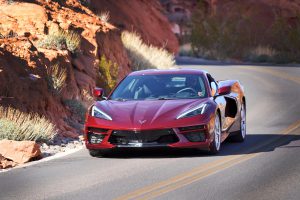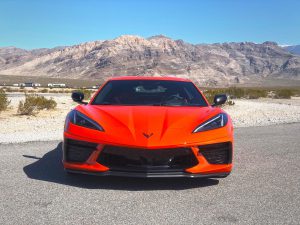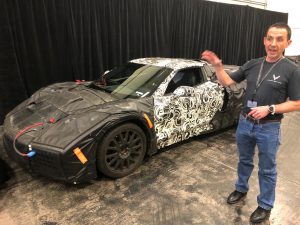More than a half century ago Zora Arkus-Duntov, the General Motors engineer often referred to as the “father of the Corvette” tried to convince the powers that be to let him develop a mid-engine version of the sports car. They turned thumbs down then, and continued to do so until shortly after GM emerged from its 2009 bankruptcy.
Finally, Arkus-Duntov’s dream has come true – though, even after showing off the new, eighth-generation Corvette last July, we’ve had to exercise patience.
The bitter strike last fall by the United Auto Workers union effectively shut GM down for more than six weeks. And, coming just as the Chevy plant in Bowling Green, Kentucky, was gearing up for launch, production was delayed even longer, the first of the new Stingrays only just rolling off the line earlier this month.
(First 2020 Corvette Stingray rolls off production line.)
Was it worth the wait? As a member of the North American Car and Truck of the Year jury, I had the good fortune of being able to get behind the wheel of a pre-production C8 in October. It was still a work in progress and, sadly, the drive lasted barely 45 minutes on relatively low-speed roads. So, it was a significant amount of anticipation that I headed out to Las Vegas earlier this week for the first real opportunity to push the 2020 Chevrolet Corvette to the limits, both on-road and off.
Shortly after landing at McCarran Airport – and even before I could check into my room –I paired up with a driving partner, grabbed a set of keys to a burgundy-esque C8 and headed back out of town for a three-hour ride.
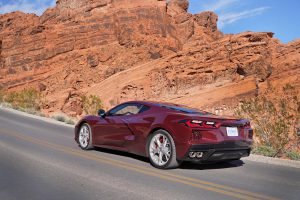
There are familiar cues to the C8 Corvette, such as the taillights, but the mid-engine layout clearly translates into a new design language.
As we walked up to our car we had to pass through a gaggle of onlookers. There’s no question that the C8 is a real eye-catcher. Indeed, everywhere we would wind up driving people would stop and stare or, on the highway, pull alongside us, phone cameras in hand.
There are certainly some Classic Corvette elements to the new car’s design. From a low angle, nose-on, you might almost think it’s just a mid-cycle refresh of the previous generation, C7 model. Same with the taillights. But stand tall and it’s remarkably different. The nose, for one, has been shortened substantially, an obvious change considering the engine has been moved amidship – which, in turn, results in a significantly elongated back end.
The driver, as I would soon experience, sits about a foot further forward, something that is more than what you might call a cosmetic difference. It actually changes the way you feel the car respond when you start to make a turn. As for moving the engine rearward, weight distribution is radically altered, 60% of the 2020 Corvette’s mass now on the back half. Among other things, that radically increases traction, especially at launch – one of the reasons why the C8, at “just” 495 horsepower with the Z51 performance pack essentially matches the acceleration of the C7 ZR1 model with 260 more hp.
The new Corvette’s design is all about aero. And that’s a lot more complex than simply making it wind-slick. The product development team needed to not only minimize air drag but also ensure maximum downforce at high speeds. The optional wing can deliver up to 400 pounds of downforce when approaching the 194 mph top speed. The third challenge was to ensure enough air to both feed and cool the engine, transmission and brakes. That results in a relatively large grille and scoops up front, as well as the additional air intakes behind each door.
One thing Chevy designers worked to carry over from Corvettes past was the surprisingly ample amount of cargo space. That is compromised a bit by the mid-engine layout, but the “frunk” under the hood offers enough new space to swallow up a couple backpacks or a modest-sized carry-on bag.
Slipping inside, we discovered an equally radical makeover. The new Corvette is being billed as “world-class,” and the materials and the detailing found on the new car live up to that claim. This is the sort of cabin we’d expect on a car costing well more than the $59,995 base – including $1,095 delivery fees – for the 2020 ‘Vette.
More than ever, the layout is that of a true driver’s car. If anything, two occupants might almost feel like they’re in separate worlds. For the driver, there’s a new, squared-off steering wheel, a design that both makes it easier to read the complex digital gauge cluster and, when driving on track, know exactly where the wheels are pointed. The new display offers a variety of customization options and, intriguingly, it can be customized separately from the optional head-up display. To the right of the cluster is the infotainment touchscreen which, again, is angled toward the driver.
The system is Chevy’s latest and, while not as sophisticated as the Mercedes-Benz MBUX voice assistant technology, is easy to learn and use.
If there is any common complaint about the 2020 Chevrolet Corvette it’s the long strip of switches that are presented as a sort of ribbon along the passenger’s side of the center console. It reminds us of the early Porsche Panamera layout, but arguably more confusing, especially the climate controls. We can imagine getting more comfortable with the layout, but it would take time.
In terms of seating, there are three options, but even the “base” option keeps you in place during most maneuvers. The track edition is nonetheless a wise choice for those who will want to spend serious time at the track.
(First Corvette C8 draws $3 million at Barrett-Jackson auction)
Visibility is much better than you might expect. That said, there are some blind spots – and new blind spot monitoring technology among other new advanced driver assistance systems on the 2020 Corvette.
After taking it all in visually, we slipped behind the wheel and hit the Start button, the C8 instantly rewarding us with a menace growl as its 6.2-liter LT2 small block V-8 came to life. As with the control strip, Chevy has taken a few hits for the odd shifter design which is closest in design to what Acura is using these days. In reality, it is quite easy to work with.
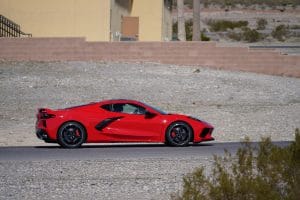
Aerodynamics clearly mattered, the development team having to maximize cooling and downforce even while minimizing wind drag.
What you won’t find on the 2020 option list is a manual transmission. For a number of reasons, the Corvette product development team decided not to offer a stick on the C8. That’s generated plenty of controversy though, as analyst Stephanie Brinley, of IHS Markit, points out, only a handful of buyers were opting for a stick on the C7, anyway.
We’ve spent at least two hours talking to various members of the Corvette team about the decision and, as we’d soon discover with time on the street and on the track, it was the right one. The new eight-speed Tremec dual-clutch transmission, or DCT, is, as the Brits would say, “brilliant.” Shifts are far faster than a human could ever manage and, time after time, always seemed to happen exactly when they should have. And, but when using Launch Control mode, they’re all but transparent, as smooth as you’d expect from a luxury touring sedan.
For those who still want to row your own, there are twin aluminum paddle-shifters. And they’re wired directly to the transmission so response time is essential instantaneous. You can also pull both in simultaneously and – as we did repeatedly to reward those gaping at the car on the Las Vegas strip – temporarily slip into neutral, allowing you to rev up that big LT2 engine.
Finally, as we cleared the last of the housing developments and strip malls that have popped up around Las Vegas like desert mushrooms, we had the opportunity to open things up. From a mere 30 mph we hit 120 much quicker than we could imagine, the car almost pleading with us to push it even further.
Equally impressive were the brakes. The new Brembos can feel grabby, at first, but it doesn’t take long to learn how to modulate them, as we learned during our second day with the 2020 Corvette, at the Spring Mountain track in Pahrump, an hour outside Sin City. We clocked lap after lap on the 2.8-mile North-South course and never experienced even the slightest sense of brake fade. But they were more than up to the task, allowing us to push deeper and deeper into the brake zones before diving into corners.
And here was where we truly learned to love the new Corvette. As we mentioned early on, sitting that far forward changes your perception of how the car steers. You feel it sooner, meaning a more direct connection between car and brain. Add the fact that, with the help of next-generation Michelin Pilot Sport tires, grip is cat-like. Steering, in turn, is absolutely precise, with weighting properly balanced for each of the different driving modes.
During the entire day I personally experienced only one moment when the rear end started to break loose. I clearly overcooked things on my first lap, missed the race line and braked late. Real amateur moves. The ‘Vette briefly scolded me with a slight sidewise slide but then instantly regained its manners and let me shoot through the next curve like a pro.
(Corvette takes home North American Car of the Year.)
And that was in Track Mode, with virtually all the “nanny” tech turned off. In normal or sport modes, the car might simply have prevented me from making such mistakes in the first place.

While the 2020 Stingray starts at just under $60,000, it’s not difficult to push it up to near $90,000 fully loaded and ready for the track.
Our track cars were equipped with not only the Z51 performance package but the optional magnetorheological suspension – mercifully shortened to MR. To sum things up, the dampers use a magnetically sensitive fluid, the computer controlled system able to switch each individual shock absorber from soft to firm, or anywhere in-between, in the time it takes the Corvette to travel just 1 inch at 60 miles per hour. What’s especially impressive about the MR system is that it works well in both worlds: on track to improve cornering and stability, while on the street it makes potholes all but vanish.
The reality, in today’s world, is that Corvette buyers will likely expect their C8 to not only handle both track and street, but also to be able to serve as a daily driver, and to operate in all weather conditions. To that effect, the new model is offered with not only summer performance tires but two Michelin alternatives, an all-season tire and even winter rubber.
Another nice touch, quite literally, is the button on the center console that raises the nose by more than an inch. That was enough, we found out, to steer off the pavement to handle a photo session without scraping the front splitter. It also can be used to deal with speed bumps and steep driveways. Hit 25 mph and the nose automatically descends to its normal height. The system even can store locations, using GPS, so it knows to automatically raise the front end as you get home from work.
There are so many of these well-thought-out features that you might think you’re dealing with a luxury sedan, rather than a high-performance sports car. And that only enhances the intrinsic value and appeal of the C8.
We had extremely high expectations for the 2020 Chevrolet Corvette and, while we might find a few nits to pick, it was difficult to come away from our two days of driving without falling in love. It’s not difficult to add to that under-$60,000 base price. The 3LT package comes in at $11,950, the Z51 option at $5,000. The MR suspension is another $1,895, and those color-coordinated seatbelts add $395. The track car we drove came in at just under $89,000.
(From “Blackjack” to Stingray: The Inside Story of How the 2020 Chevrolet Corvette Came to Be.)
But compare that to anything else on the road that can deliver that level of performance – and features, starting with a Porsche 911, and the C8 is an absolute bargain. But it doesn’t behave like one. We’ve long heard Chevy promise to deliver a true world-beater Corvette. They’ve finally pulled it off. It’s been a long wait, but Zora Arkus-Duntov would be proud.

